Derek the Hybrid Detective
DD0809 Tillandsia mooreana Complex
T.mooreana, kalmbacheri, inflata, and cretacea.
by Derek Butcher August 2009
As at Aug 2009 UD has a file called 'Mooreana Complex containing data
on T. mooreana, T. kalmbacheri and T. cretacea."
Attempts at clearly seperating these have "done the rounds" of fellow Tillandsia experts but the waters are still fairly muddied.
The "official" descriptions follow, and comments from Renate Ehlers have been included.
If any reader has a brainstorm of a solution the case will be reopened!
Tillandsia cretacea L. B. Smith, Phytologia 28: 31, pl. 3, figs. A, B. 1974.
A T. inflata Mez, cui valde affinis, spicis laxis, internodii longioribus, bracteis florigeris angustioribus differt
Differs from T. inflata Mez, to which it is closely related, by the lax spikes, the longer internodes, and the narrower floral bracts.
Desc from S&D p965
Plant known only from fragments but probably stemless and flowering over 1 m high.
Leaves ca 50 cm long, bearing minute, appressed, brown-centered scales throughout;
Sheaths ample, densely lepidote, brownish;
Blades narrowly triangular, attenuate, 5 cm wide at base, laxly lepidote, green.
Scape unknown.
Inflorescence laxly bipinnate, over 32 cm long, white-cretaceous except the petals;
Primary bracts broadly ovate, apiculate, about equaling the 1-bracteate sterile base of the spike;
Spikes oblong, acute, 20 cm long, laxly many-flowered; rhachis straight or nearly so, narrowly winged. (aligned mainly vertical not flat side to axis – Luther 2002)
Floral bracts strongly divergent at anthesis, 32 mm long, 3 times the internodes and about equaling the sepals, broadly elliptic, apiculate, ecarinate, inflated, probably fleshy because wrinkled and nerveless when dry, inconspicuously lepidote; pedicels short.
Sepals all alike, elliptic, 28 mm long, ecarinate;
Petals ca 45 mm long, drying violet;
Stamens and style exserted.
Type I. Knobloch 564 (holotype US), on igneous rocks, La Bufa, southeast of Creel, Chihuahua, Mexico, 22 Sep 1957.
DISTRIBUTION. Known from the type collection only.
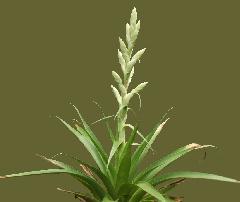
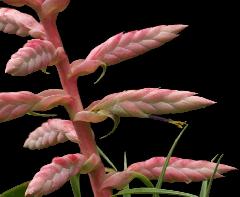
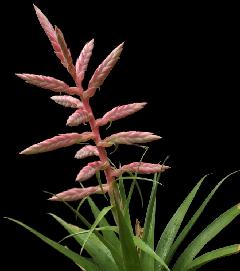
Tillandsia kalmbacheri Matuda, Cact. & Sucul. Mex. 19: 26, fig. 16. 1974.
Desc from S&D p1395
Plant stemless, flowering to 50 cm or often higher.
Leaves utriculate-rosulate;
Sheaths broadly ovate, 7 cm long, 6 cm wide, sublilac;
Blades narrowly triangular, caudate, 40 cm long, 6 cm wide, nearly flat but involute toward apex, sparsely white-lepidote.
Scape erect, 30 cm long, stout, roseate;
Scape-bracts imbricate, semi-amplexicaul, the blades foliaceous, spreading 30-35 cm long, 5 cm wide, roseate, sparsely lepidote.
Inflorescence erect, 4-5-branched;
Primary bracts like the upper scape-bracts, reflexed, their sheaths shorter than the axillary spikes, short-stipitate, subquadrilateral, 12 cm long, 4 cm wide, 16-20 flowered.
Floral bracts laxly imbricate, orbicular, mucronate, 35 mm long, inflated, carinate or ecarinate, inflated, not exposing the axis, yellow-green, sparsely leipdote at apex.
Sepals 25 mm long, 7 mm wide, subcarinate, subchartaceous, glabrous, yellow-green; Petals tubular-erect, 55 mm long, yellow-green;
Stamens and style long-exserted.
Type. On oaks, Rincon de la Via, Guerrero, Mexico, 7 Oct 1973, H. Kruse 3119 (holotype MEXU n v).
Distribution. Known from the type collection only.
According to its author, Tillandsia kalmbacheri resembles T. mooreana L. B. Smith (T. inflata Mez, non Baker), but differs in its much broader leaves, roseate, long-acuminate primary bracts, loosely imbricate, yellowish green floral bracts, and yellowish green petals.
NOTE. This taxon is difficult to identify in the wild . It shares the same locality and climatic conditions as T. mooreana. The only striking difference is in the colour of the petals where T. kalmbacheri is green and T. mooreana is violet/purple.
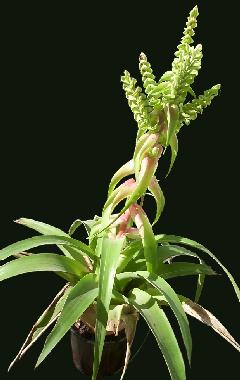
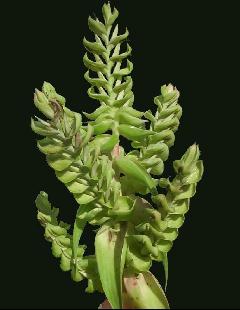

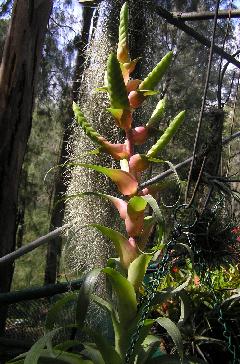
| Ian Hook 06/06, owned by Neville Ryan Qld. |
Photo Ken Woods, owned by David Sheumack. |
Tillandsia mooreana L. B. Smith, Phytologia 20: 167. 1970; nomen nov.
Tillandsia inflata Mez, DC. Monogr. Phan. 9: 701. 1896, non Baker 1886.
NOTES from Phytologia 20: 167. 1970 – T. MOOREANA L. B. Smith, nom. nov. T. inflata Mez in DC. Mon, Phan. 9: 701. 1896, non Baker, 1886; Pflr.757. TIL. The new specific name is in honor of Harold E. Moore, Jr., to whom I am indebted for beautiful material of this and many other species.
Desc from S&D p999
Leaves 55 cm long, green, densely and minutely pale-appressed-lepidote;
Sheaths elliptic, large, indistinct;
Blades narrowly triangular, caudate-attenuate, flat, 4 cm wide.
Scape stout, erect or ascending, to 2 dm long, glabrous;
Scape-bracts foliaceous, spreading or reflexed-spreading, linear-lanceolate, filiform-caudate, to 2 dm long, many times as long as the internodes, 25 mm wide, coarsely pale-pruinose-lepidote toward apex.
Inflorescence bipinnate, 4-10 dm long, 25 cm in diameter;
Primary bracts like the scape-bracts, the lower ones exceeding the axillary spikes, the upper shorter;
spikes erect or divergent, oblong, 1-2 dm long, 35-45 mm wide, 14-20-flowered, (Flat side facing the axis – Luther 2002)
Rhachis straight, glabrous.
Floral bracts spreading and exposing the sepals and rhachis although three to four times as long as the internodes, suborbicular, mucronulate, 3 cm long, equaling or exceeding the sepals, inflated, ecarinate, glaucous outside, lepidote inside, roseate, finely nerved, thick subchartaceous, probably fleshy in life, finely verrucose;
Flowers subsessile, divergent.
Sepals broadly elliptic, acute, 25-30 mm long, ecarinate, subcoriaceous, even or nerved, glabrous, evenly connate for 3 mm;
Petals purple, 4 cm long, the claw linear, the blade elliptic, obtuse, narrowly white-margined;
Stamens and pistil exserted.
Type. Roezl s n (holotype LG, GH photo), without exact locality, Mexico, 1873. DISTRIBUTION. Epiphytic, 900-1800 m alt, Mexico. MEXICO. SONORA: Sierra Charuco, Rio Maya, 11 Oct 1935, Gentry 2032 (F). JALISCO: Tecalitlan, 22 Sep !958, McVaugh 18137 (MICH, US); 19 Nov 1970,24486 (MICH). GUERRERO: km 339-340, Acahuizotla to Agua de Obispo, 20 Aug 1948, Moore & Wood 4704 (BH, US). OAXACA: Santa Maria Ecatepec, 3 Dec 1950, MacDougall 5 (MEXU, US).
NOTE This taxon is difficult to identify in the wild . It shares the same locality and climatic conditions as T. kalmbacheri. The only striking difference is in the colour of the petals where T. kalmbacheri is green and T. mooreana is violet/purple.
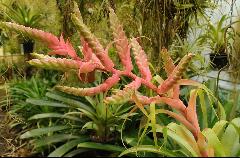


| Peter Tristram 07/09. T. aff. mooreana (inflata ex Lau.) |
Flowered by Peter Tristram, originally from Maurice Kellet as inflata ex Lau.
Some debate whether kalmbacheri, mooreana, cretacea, inflata, or something else.
Maurice Kellet advises it's from seed from Alfred Lau in the late 70's but not named with great confidence.
Derek Butcher reminded us of name change and notes...
"I had thought that petal colour would help in identification (green or violet blue) but there is too much confusion here. Harry says that in his opinion where the branches are vertical (flat side at right angles to the axis) you have T. cretacea, or horizontal (flat side to the axis) you have T. mooreana. Armed with this information you see that the plant in Peter's photo covers both, which means the plant does not know if it is Arthur or Martha !
I would suggest this be called T. aff. mooreana ( inflata ex Lau.). If we put photos on the Aust. website, others can look up the reference in years to come when they flower that T. inflata from Maurice."
T. inflata Mez in DC. Monogr. Phaner. IX. (1896) 701.
Desc from Mez 1935
Folia ignota. Scapus validus, ad 0,2 m longus, vaginis perlonge filiformi-acutis, internodia superantibus indutus. Inflorescentia submultiflora, 2-pinnatim panniculata, e spica terminali majore spicisque 3-8 lateralibus minoribus composita, ad 0,4 m longa et 0,25 m diam. metiens; spicis subpinnatis, infimis quam bracteae primariae brevioribus reliquis eas superantibus, saepius ultra 25-floris, subsessilibus, erectis vel suberectis, ad 0,1 m longis et 35 mm latis, linearibus; bracteis primariis vaginis scapalibus isomorphis; bracteis florigeris recurvo-patentibus, sueto nec imbricatia nec axes obtegentibus, dorso glabris et tenuiter prominulo-venosis, valde inflato-concavis nullo modo carinatis, carnose coriaceis, explanatis fere perfecte orbicularibus, apice rotundatis mucroneque tenui permanifesto imposito auctis, ad 30 mm longis, sepala superantibus nec obtegentibus. Flores brevissime pedicellati fere sessiles; sepalis basi ad 3 mm connatis, coriaceis, dorso glabris laevibusque, late ellipticis, acutiusculis, symmetricis, ad 25 mm longis. Petala ignota:
Mexico : ohne Standortsangabe von Roezl lebend eingesandt, aber nicht in Kultur ubergegangen.
Leaves unknown
Scape robust, to 20cm long, clothed with long filiform sheaths, exceeding the internodes.
Inflorescence many flowered, a bipinnate panicle, from the larger terminal spikes there are 3-8 lateral smaller spikes, to 40cm long and 25cm wide at the middle.
Spikes subpinnate, the lowest ones shorter than the primary bracts, the remainder exceeding them, often more than 25 flowered, subsessile, erect to sub-erect, to 10cm long and 35mm wide, linear.
Primary bracts the same shape as the scape sheaths.
Floral bracts recurved spreading, not imbricate, not concealing the rhachis, the back glabrous and finely prominently veined, strongly inflated concave, in no way carinate, fleshy-leathery, flattened nearly perfect orbicular, tip rounded with a slender mucron, to 3cm long, exceeding the sepals not hiding them.
Flowers with the smallest pedicel, almost sessile
Sepals connate for 3mm, leathery, back glabrous, smooth, broad-elliptic, becoming acute, symmetric, to 25mm long
Petals unknown
Mexico: without location from Roezl as a living specimen, but not grown on in culture.
Luther 2002 suggests that T. inflata should be a synonym of T. cretacea which indicates that the type for T. mooreana should be Moore and Wood 4704 !
Tillandsia inflata.
L.B.Smith 1970 renamed to T. mooreana.
Luther 2002 suggests that T. inflata should be a synonym of T. cretacea which indicates that the type for T. mooreana should be Moore and Wood 4704 !
Two others originally named Tillandsia inflata have been moved to Vr. inflata and Vr. heterostachys.
Tillandsia mooreana notes by R Ehlers.
Nov 1992. So far this year I have been kept busy with this plant.
In 1983 we made a special trip to find this species near Maria Ecatepec in Oaxaca. We followed an out-of-the-way road where robbery gives a bad name to this small town in the hills. The road was very bad and we stopped by a bridge over a deep stream. Unfortunately we only found a T. bourgaei and T. calothyrsus.
T. mooreana has totally unkeeled sepals (refer also Subkey VII in S&D) and is supposed to have violet flowers and while I believe that T. mooreana and . kalmbacheri are two distinct plants Sue Gardner in her dissertation could not find any distinction when examining various herbarium specimens.
Lotte Hromadnik collected a plant which she believes is T. aff. mooreana in Guerrero in the stretch between Salitrera and Altimirano in March 1991. In autumn 1992 I collected 3 plants on the road to Altamirano and they flowered in my garden and all seem different to the collection made a year before.
EM911310 Salitrera-Altamirano, Guerrero. This plant had 14 spikes in a compound inflorescence. The flower in the early part of the day was a shiny yellow, the next day greenish yellow then becoming brown. The sepals were keeled.
EM871705 Tecalitlan (near Tuxpan) road to Jilotlan de lo Dolores, Jalisco. Plant has spikes in a compound inflorescence, flower colour and keeled sepals like EM911310. The plant that I collected is different to T. hintoniana. It grows in a tree with flowering T. hintoniana (the type that grows in the area has green leaves and shiny pink floral bracts, in most other areassuch as near Uruapam the plant grows in masses with leaves red and floral bracts greenish yellow). The specimen from Tecalitlan is near to Smith’s T. mooreana. McVaugh = “ determinations confirmed by J Utley 1985” McVaugh in Flora Novo Galiciana p61-2 reported by Smith as ‘purple’ but in ours (collected near Tecalitlan yellow or lemon.
EM8311 Acahuizotla, Guerrero. The plant has spikes in a compound inflorescence, flower colour and keeled sepals as in EM911310 & EM871705.
In June 1983 we travelled from El Rincon de la Via where we collected T. kruseana on a piece of highway in the direction of Chilpancingo and on a bend in a side road near Acahuizotla we found an interesting hybrid between T. fasciculata and T. capitata. This area will always be remembered because I had a dog attack me through an open window! Here we collected a green funnel shaped Tillandsia which I could not name and with some misgiving I treated it as T. mooreana. The type locality for T. kalmbacheri is Rincon de la Via, Guerrero It makes you wonder, when you see the collection area for T. mooreana is Acahuizotla to Agua de Obispo is only a few km away. We have 2 similar but different plants growing in the same neighbourhood. But with different flower colour, floral bract colour and sepal detail must make these two different species. The fact that plants from 2 collection areas each having yellow flowers and keeled sepals decreases the chance of an error having been made in the description. The only difference remaining is that T. kalmbacheri has green bracts and T. mooreana red or red-green. The colouring of the floral bracts varies according to the strength of the light intensity. the much wider leaves of T. kalmbacheri Matuda is not a valid characteristic because all large plants vary strongly.
The only real difference is the distinct and strong keeled sepal ( in T. kalmbacheri). Neither Gardner, nor McVaugh, nor Utley refers to this characteristic and yet Smith writes explicitly “posterior and anterior sepals ecarinate, alike. owadays we preserve fresh material but I can however, barely demonstrate that the sepal keel is lost when dry. (1.10. 1993 – the sepal stays keeled in a dry state)
Result – And yet T. kalmbacheri is considered a synonym of T. mooreana.
A plant from Oaxaca from the stretch Pochutla – Miahuatlan is coming into flower. The plant is very large and has leathery, strongly lepidote leaves. I am of the opinion that on the basis of the green-yellow flower and keeled sepals it is not T. mooreana. It remains to be established whether there is sufficient difference between my plant and what one would expect for T. mooreana. Plants similar to the type come from the stretch Oaxaca to Puerto Escondito at a height of 1000-1500m in very large numbers and certainly between San Gabriel on the ascent to the Pass and on the descent towards Sola de Vega.
5. 10. 1993. EM912102. Pochutla – Miahuatlan flowered in May-June 1993. The inflorescence has 20 compound spikes and 50cm high. There is barely any difference to the other type of T. mooreana, a plant from Oaxaca that is often larger and has a larger inflorescence with more tha 20 side spikes. The leaves are stronger scaled, often grey-red or grey-pink while the plant from Guerrero is greener, often the leaves are green with large red blotches.
Plant collected in Chiapas in a coffee plantation near Motosindla by R Wulfinghoff shows in a varying habitat the spikes are very long and the internodes of the flower bracts very small. However, I cannot establish any vital difference from T. mooreana.
A variation from T. mooreana is, in any case, the plant from Sierra El Tuito, South of Puerto Vallarta. The leaves are thinner, dark green with red blotches and not lepidote or a few appressed lepidote so weak that it seems glabrous.The flower is very laxly arranged, the rhachis at anthesis strongly visible, the petals are violet with white edges. Perhaps this is the reason why Smith may have one plant from the types being collected near Rio Mayo, Sonora (H S Gentry 2032 in his Rio Mayo plants 1942.)
A similar variation is a plant that has been collected in Zacatecas on Mount Escobedo –Schucht and in the Sierra de Cora (stretch Valpairaiso to Jesus Maria behind Jesus Maria) which is dark green, shows unscaled leaves, sprouting at the base, dense internodes, light green chalky bracts and violet petals. Rhachis not visible at anthesis. Also we must wait patiently for a plant to flower for us.
A plant discovered by L & H Hromadnik growing on rocks on the stretch from Altamirano to the Pacific coast we have heard is another regional form. the plant is green and very large. Here again we must wait.
In between times a plant has been described as T. trauneri (SW of Altamirano, 1100m on rocks). I believe this is closer to T. cretacea. Photos and plant material from Pam Koide of T. cretacea show similar size, the spike is practically the same, besides which the floral bracts are cretaceous. T. cretacea and T. trauneri are terrestrial and T. mooreana epiphytic.
Updated 09/08/09












